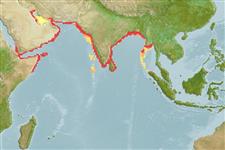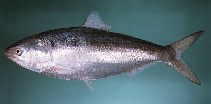Add your observation in Fish Watcher
| Native range | All suitable habitat | Point map | Year 2050 |

|
| This map was computer-generated and has not yet been reviewed. |
| Tenualosa ilisha AquaMaps Data sources: GBIF OBIS |
Upload your photos and videos
Pictures | Stamps, coins, misc. | Google imageTenualosa ilisha
Picture by Randall, J.E.
Pictures | Stamps, coins, misc. | Google imageTenualosa ilisha
Picture by Randall, J.E.
India country information
Common names:
௨ள்ளம், ௨ள்ளம் , Chakshi
Occurrence: native
Salinity: freshwater
Abundance: | Ref:
Importance: highly commercial | Ref:
Aquaculture: experimental | Ref:
Regulations: | Ref:
Uses: no uses
Comments: Found in Chilka Lake (Ref. 29108), Ganga, Yamuna, Narmada, Tapi, Krishna, Godavary, Cauvery, and Pennar rivers (Ref. 43638). Reported from Fenny river at Sabroom, Tripura (Ref. 97593). Occurs in coastal waters, rivers, Bay of Bengal and river mouths (Ref. 45255). Artificial propagation has been partially sucessful (Ref. 4832). Most popular esteemed food fish (Ref. 33273). Also Ref. 188. Status of threat: Vulnerable in Western Ghats (Ref. 50614).
National Checklist:
Country Information: https://www.cia.gov/library/publications/resources/the-world-factbook/geos/in.html
National Fisheries Authority:
Occurrences: Occurrences Point map
Main Ref: Kapoor, D., R. Dayal and A.G. Ponniah, 2002
National Database:
Occurrence: native
Salinity: freshwater
Abundance: | Ref:
Importance: highly commercial | Ref:
Aquaculture: experimental | Ref:
Regulations: | Ref:
Uses: no uses
Comments: Found in Chilka Lake (Ref. 29108), Ganga, Yamuna, Narmada, Tapi, Krishna, Godavary, Cauvery, and Pennar rivers (Ref. 43638). Reported from Fenny river at Sabroom, Tripura (Ref. 97593). Occurs in coastal waters, rivers, Bay of Bengal and river mouths (Ref. 45255). Artificial propagation has been partially sucessful (Ref. 4832). Most popular esteemed food fish (Ref. 33273). Also Ref. 188. Status of threat: Vulnerable in Western Ghats (Ref. 50614).
National Checklist:
Country Information: https://www.cia.gov/library/publications/resources/the-world-factbook/geos/in.html
National Fisheries Authority:
Occurrences: Occurrences Point map
Main Ref: Kapoor, D., R. Dayal and A.G. Ponniah, 2002
National Database:
Common names from other countries
Classification / Names ชื่อสามัญ | ชื่อพ้อง | Catalog of Fishes(สกุล, ชนิด) | ITIS | CoL | WoRMS | Cloffa
> Clupeiformes (Herrings) > Dorosomatidae (Gizzard shads and sardinellas)
Etymology: Tenualosa: Latin, tenuis = thin + Latin, alausa = a fish cited by Ausonius and Latin, halec = pickle, dealing with the Greek word hals = salt; it is also the old Saxon name for shad = "alli" ; 1591 (Ref. 45335).
More on author: Hamilton.
Etymology: Tenualosa: Latin, tenuis = thin + Latin, alausa = a fish cited by Ausonius and Latin, halec = pickle, dealing with the Greek word hals = salt; it is also the old Saxon name for shad = "alli" ; 1591 (Ref. 45335).
More on author: Hamilton.
Environment: milieu / climate zone / depth range / distribution range นิเวศวิทยา
เกี่ยวกับทะเล,น้ำเค็ม; น้ำจืด; กร่อย; ปลาที่อพยพจากแหล่งน้ำเค็มไปวางไข่ในแหล่งน้ำจืด (Ref. 127664); ระดับความลึก ? - 200 m. Tropical; 34°N - 5°N, 42°E - 97°E (Ref. 188)
การแพร่กระจาย ประเทศต่างๆ | พื้นที่จำแนกตาม FAO | ระบบนิเวศหลายระบบ | การปรากฏขึ้น,การเกิดขึ้น,พบ | Point map | การแนะนำ | Faunafri
Indian Ocean: Persian Gulf eastward to Myanmar, including western and eastern coasts of India. Reported from the Gulf of Tonkin, Viet Nam (Ref. 9706). Reported in Tigris River basin and probably other rivers of southern Iran (Ref. 39702).
Length at first maturity / ขนาด / น้ำหนัก / Age
Maturity: Lm 31.3, range 18 - ? cm
Max length : 60.0 cm SL เพศผู้/กระเทย; (Ref. 188); common length : 36.0 cm SL เพศผู้/กระเทย; (Ref. 4832); common length :42 cm TL (female); น้ำหนักสูงสุดที่มีการรายงาน: 680.00 g (Ref. 4832); น้ำหนักสูงสุดที่มีการรายงาน: 680.00 g; อายุสูงสุดที่ได้รายงาน: 5 ปี (Ref. 43871)
Max length : 60.0 cm SL เพศผู้/กระเทย; (Ref. 188); common length : 36.0 cm SL เพศผู้/กระเทย; (Ref. 4832); common length :42 cm TL (female); น้ำหนักสูงสุดที่มีการรายงาน: 680.00 g (Ref. 4832); น้ำหนักสูงสุดที่มีการรายงาน: 680.00 g; อายุสูงสุดที่ได้รายงาน: 5 ปี (Ref. 43871)
Short description เครื่องมือที่ใช้ในการแยกชนิดสัตว์,สิ่งมีชีวิตออกจากกัน | สัณฐานวิทยา | ความยาวต่างๆ
เงี่ยงครีบหลัง (รวม) : 0; ก้านครีบอ่อนที่หาง (รวม) : 18 - 21; เงี่ยงครีบก้น: 0; ก้านครีบอ่อนที่ก้น: 18 - 23. Belly with 30 to 33 scutes. Distinct median notch in upper jaw. Gill rakers fine and numerous, about 100 to 250 on lower part of arch. Fins hyaline. A dark blotch behind gill opening, followed by a series of small spots along flank in juveniles. Color in life, silver shot with gold and purple.
Schooling in coastal waters and ascending rivers for as much as 1200 km (usually 50-100 km). Migration though is sometimes restricted by barrages. Hilsa far up the Ganges and other large rivers seem to be permanent river populations. Feeds on plankton, mainly by filtering, but apparently also by grubbing on muddy bottoms. Breeds mainly in rivers during the southwest monsoon (also from January to February to March). Artificial propagation has been partially successful in India (Ref. 4832). Known to be a fast swimmer, covering 71 km in one day (Ref. 12203). Marketed fresh or dried-salted.
Life cycle and mating behavior วัยเจริญพันธุ์ | การสืบพันธุ์ | การวางไข่ | เซลสืบพันธ์ของเพศเมีย(ไข่) | ความดกของไข่ | ตัวอ่อน
Breeds mainly in rivers, upstream to about 50 km or even over 1000 km as in the Ganges (younger fishes may breed in the tidal zone of rivers). In some rivers the migration is restricted by barrages; there is some evidence that hilsa far up the Ganges and other large rivers, although migrating upstream to spawn, are permanent river populations that do not descend to the sea. The main breeding season is during the southwest monsoon, with a shorter season from January to February or March.
Main reference
Upload your references | อ้างอิง | ผู้ประสานงาน | ผู้ร่วมมือ
Whitehead, P.J.P., 1985. FAO Species Catalogue. Vol. 7. Clupeoid fishes of the world (suborder Clupeoidei). An annotated and illustrated catalogue of the herrings, sardines, pilchards, sprats, shads, anchovies and wolf-herrings. FAO Fish. Synop. 125(7/1):1-303. Rome: FAO. (Ref. 188)
IUCN Red List Status (Ref. 130435: Version 2024-2)
Least Concern (LC) ; Date assessed: 23 January 2013
Threat to humans
Harmless
Human uses
การประมง: มีการค้าเพียงเล็กน้อย; การเพาะเลี้ยงสัตว์น้ำ: การทดลอง
FAO(การประมง: การผลิต; publication : search) | FishSource | ทะเลรอบๆเรา
ข้อมูลเพิ่มเติม
Population dynamics
Growth parameters
Max. ages / sizes
Length-weight rel.
Length-length rel.
Length-frequencies
Mass conversion
การทดแทนที่
อุดมสมบรูณ์
Growth parameters
Max. ages / sizes
Length-weight rel.
Length-length rel.
Length-frequencies
Mass conversion
การทดแทนที่
อุดมสมบรูณ์
Life cycle
การสืบพันธุ์
วัยเจริญพันธุ์
ความดกของไข่
การวางไข่
Spawning aggregations
เซลสืบพันธ์ของเพศเมีย(ไข่)
Egg development
ตัวอ่อน
พลวัตของสัตว์น้ำวัยอ่อน
การสืบพันธุ์
วัยเจริญพันธุ์
ความดกของไข่
การวางไข่
Spawning aggregations
เซลสืบพันธ์ของเพศเมีย(ไข่)
Egg development
ตัวอ่อน
พลวัตของสัตว์น้ำวัยอ่อน
Distribution
ประเทศต่างๆ
พื้นที่จำแนกตาม FAO
ระบบนิเวศหลายระบบ
การปรากฏขึ้น,การเกิดขึ้น,พบ
การแนะนำ
BRUVS - Videos
ประเทศต่างๆ
พื้นที่จำแนกตาม FAO
ระบบนิเวศหลายระบบ
การปรากฏขึ้น,การเกิดขึ้น,พบ
การแนะนำ
BRUVS - Videos
Physiology
Body composition
Nutrients
การใช้ออกซิเจน
รูปแบบการว่ายน้ำ
ระดับความเร็วในการว่ายน้ำ
Visual pigments
Fish sound
Diseases & Parasites
Toxicity (LC50s)
Body composition
Nutrients
การใช้ออกซิเจน
รูปแบบการว่ายน้ำ
ระดับความเร็วในการว่ายน้ำ
Visual pigments
Fish sound
Diseases & Parasites
Toxicity (LC50s)
Genetics
พันธุศาสตร์
Heterozygosity
อัตราพันธุกรรม
พันธุศาสตร์
Heterozygosity
อัตราพันธุกรรม
Human related
Aquaculture systems
ประวัติการเพาะเลี้ยงสัตว์น้ำ
สายพันธุ์
Ciguatera cases
Stamps, coins, misc.
Aquaculture systems
ประวัติการเพาะเลี้ยงสัตว์น้ำ
สายพันธุ์
Ciguatera cases
Stamps, coins, misc.
เครื่องมือ
E-book | คู่มือภาคสนาม | เครื่องมือที่ใช้ในการแยกชนิดสัตว์,สิ่งมีชีวิตออกจากกัน | ผู้มีความชำนาญในเรื่องความถี่ของความยาว | เครื่องมือในการศึกษาชีวประวัติ | ตำแหน่งบนแผนที่ | Classification Tree
| Catch-MSY |
Special reports
Download XML
แหล่งที่มาจากอินเตอร์เน็ต
Aquatic Commons | BHL | Cloffa | Websites from users | Check FishWatcher | CISTI | Catalog of Fishes(สกุล, ชนิด) | DiscoverLife | ECOTOX | Faunafri | Fishtrace | GenBank(genome, nucleotide) | GloBI | GOBASE | | Google Books | Google Scholar | Google | IGFA World Record | MitoFish | Otolith Atlas of Taiwan Fishes | PubMed | Reef Life Survey | Scirus | SeaLifeBase | แผนภูมิชีวิตแบบต้นไม้ | Wikipedia(Go, ค้นหา) | World Records Freshwater Fishing | บันทึกทางด้านสัตววิทยา
Estimates based on models
Preferred temperature (Ref. 115969): 21.3 - 28, mean 24.7 (based on 224 cells).
Phylogenetic diversity index (Ref. 82804): PD50 = 0.5312 [Uniqueness, from 0.5 = low to 2.0 = high].
Bayesian length-weight: a=0.00891 (0.00790 - 0.01006), b=3.05 (3.02 - 3.08), in cm Total Length, based on LWR estimates for this species (Ref. 93245).
ระดับชั้นอาหาร (Ref. 69278): 2.9 ±0.29 se; based on food items.
ความสามารถในการกลับคืนสู่ปกติ (Ref. 120179): ขนาดกลาง, เวลาต่ำสุดที่จะทำให้ประชากรเพิ่มขึ้นเป็น 2 เท่าใช้เวลา 1.4 - 4.4 ปี (K=0.3-1.2; tmax=5; tm=2; Fec=220,000).
Prior r = 0.59, 95% CL = 0.39 - 0.89, Based on 4 data-limited stock assessments.
Fishing Vulnerability (Ref. 59153): Low to moderate vulnerability (29 of 100).
Climate Vulnerability (Ref. 125649): Very high vulnerability (84 of 100).




